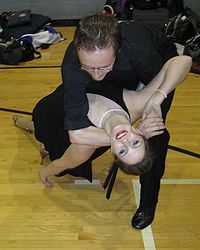.gif)
Dip (dance move)
Encyclopedia

Dance
Dance is an art form that generally refers to movement of the body, usually rhythmic and to music, used as a form of expression, social interaction or presented in a spiritual or performance setting....
forms (Tango
Tango (dance)
Tango dance originated in the area of the Rio de la Plata , and spread to the rest of the world soon after....
, Lindy Hop
Lindy Hop
The Lindy Hop is an American social dance, from the swing dance family. It evolved in Harlem, New York City in the 1920s and '30s and originally evolved with the jazz music of that time. Lindy was a fusion of many dances that preceded it or were popular during its development but is mainly based...
, Salsa
Salsa (dance)
Salsa is a syncretic dance form with origins in Cuba as the meeting point of Spanish and African cultures.Salsa is normally a partner dance, although there are recognized solo forms such as solo dancing "suelta" and "Rueda de Casino" where multiple couples exchange partners in a circle...
, Ballroom dance
Ballroom dance
Ballroom dance refers to a set of partner dances, which are enjoyed both socially and competitively around the world. Because of its performance and entertainment aspects, ballroom dance is also widely enjoyed on stage, film, and television....
s).
Standard: The flyer usually balances herself. The flyer's body may be horizontal or vertical. There are many grips for bases. The base uses a one-handed grip if flyer is experienced. In performance, flyer may turn her torso sideways toward the audience or toward the base. In social dance, they flyer usually turns her torso toward the base. The lead can use a two-handed grip for inexperienced partners when social dancing.
Tango: The follow's leg locks around the lead's right leg. The flyer can support herself, if she has strong stomach muscles.
Tango Swoop: The flyer leans back (torso horizontal) and moves in a circle and then returns to vertical.
Shoulder Support (Right): When the follow spins to her left, the lead may grip her left shoulder with his right arm. She will stop spinning when his right arm blocks her body. This leads to a natural dip, where she simply leans back while he supports her by holding her shoulder. Note: Never hold her neck.
Shoulder Support (Left): When the follow spins to her left, the lead may grip her left shoulder or upper arm, with his left hand. She will stop spinning when his arm left blocks her body. During her spin, the lead's right hand holds the follow's right hand. This leads to a natural dip, where she simply leans back, while he supports her with both hands: his right hand holds her right hand behind his neck and his left hand holds her left shoulder.
Lean: The base and flyer stand side by side, with the base's hand on her hip. The base lunges sideways, away from the flyer, holding her hip to his. She keeps one leg straight and styles with the other, often a figure-4 knee bend.
Lean to Standard: From a lean, the follow rolls forward into a normal dip.
Between the Legs: The lead steps over her torso.
Straddle: The flyer bends back horizontally. The lead steps over her torso, then moves his feet together so his feet touch. The flyer is supported by his feet.
Death Drop: From cuddle position, with a circus grip. Flyer leans forward and falls as far a grip allows, which is not very far. Then the lead slips the cuddle arm out and the flyer falls again as far as the grip allows. Spotters should be under where the flyer's head will go.
One-handed coin swooping dip (Trance): Whilst dipping your partner with the one handed gripping technique, lower your torso until in a vertical position and within reach of the dance floor. There is a slight pelvic sway in sync with the trance beat. With your free hand collect the coin, and then return to the upright position. The position of your leading thigh is key in making this popular move successful

